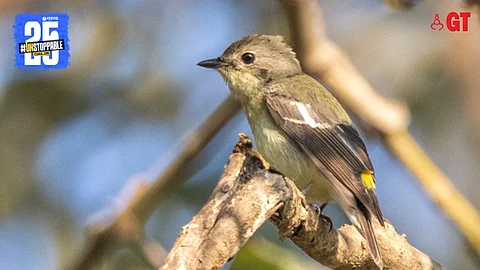

Over the past decade, Goa has steadily emerged as a paradise for birders, thanks to its remarkable variety of bird species.
Now, the State adds another feather to its cap with the release of the 7th version of the Goa Bird Checklist, which documents 497 scientifically verified species — bringing India’s smallest state within reach of the coveted 500-species milestone.
This remarkable achievement highlights Goa’s exceptional avian diversity, with nearly 40% of all bird species found in the Indian subcontinent documented within just 3,702 sq km. The checklist, authored by Dr Pronoy Baidya and Mandar Bhagat, was published in the Indian Birds journal.
The checklist includes eight newly recorded species, discovered through the efforts of various birdwatchers and research agencies.
“This discovery highlights both the State’s marine bird diversity and ongoing conservation efforts. The taxonomic updates follow the 2025 guidelines established by Praveen J and Dr Rajah Jayapal in their annual revision of Indian bird classifications,” says Dr Pronoy Baidya, scientist and Head of the Research and Consultancy Division at the Morlem-based Arannya Environment Research Organisation.
The checklist includes eight newly recorded species, discovered through the efforts of various birdwatchers and research agencies.
Five, of the eight, newly added species are seabirds, highlighting the vital role of of Goa’s coastal ecosystems.
“Among these marine additions, the short-tailed shearwater and white-tailed tropicbird were documented through the Marine Stranding Network, a collaborative partnership between the Goa Forest Department, Drishti Marine and Reef Watch,” adds Dr Baidya.
It also involves species like the lesser noddy, recorded at Galgibaga in South Goa by Goa University Research Scholars, Sagar Naik and Shubham Rane, initially reported and subsequently rescued by the Marine Stranding Network.
A great frigatebird sighting, by sea watchers from Fort Aguada, further enriched the marine species list, while perhaps most remarkably, the streaked shearwater was documented off Goa’s coast by the research team, led by Jalmesh Karapurkar and Baidya after several attempts over the last decade, as part of the Goa Bird Atlas Project.
Terrestrial bird additions provide equally compelling insights into Goa’s ecological complexity. Jerdon’s bushlark, typically associated with dry grasslands of southern India, was reported by Omkar Damle from the Succoro plateau, suggesting possible range expansions or habitat adaptations.
The discovery of the rare yellow-rumped flycatcher in the Tamdi Surla forest area of Bhagwan Mahavir Wildlife Sanctuary by Kuldip Topo and Parag Rangnekar adds another layer to understanding the Western Ghats’ biodiversity hotspot characteristics.
The discovery of the rare yellow-rumped flycatcher in the Tambdi Surla forest area of Bhagwan Mahavir Wildlife Sanctuary by Kuldip Topo and Parag Rangnekar adds another layer to understanding the Western Ghats’ biodiversity hotspot characteristics.
“Perhaps most intriguing is the inclusion of the African openbill, initially reported by Aparna Laad from Majorda in 2021. This species remained in scientific limbo for four years, classified as having ‘unknown origin’ until a subsequent sighting in Kerala in 2023 prompted scholarly reassessment,” informs Dr Baidya.
“Following scientific discussions published in the Indian Birds journal, researchers now recognise this species as a climate change-influenced stray visitor to India, representing the evolving migration patterns of this largely resident African water bird,” he adds.
This checklist is not just for academic ornithology, but it also serves as a foundational tool for policymaking and conservation planning. It is also Goa’s largest citizen science initiative, which is the need of the hour as such documentation helps in better planning and understanding of our ecology.
This documentation also supports Goa’s growing bird-watching tourism industry. It encourages regular and systematic observations by both residents and visitors alike.
This documentation also supports Goa’s growing bird-watching tourism industry. It encourages regular and systematic observations by both residents and visitors alike.
However, with such rich avian biodiversity comes the responsibility of preserving these vital habitats — not just for birds, but for other dependent species as well. Maintaining these ecosystems is crucial for their continued survival and for the overall ecological balance.
In the near future, Goa may surpass the milestone of 500 recorded bird species. This achievement will place an even greater responsibility on us, as citizens, to actively protect and sustain these habitats for the benefit of current and future generations.